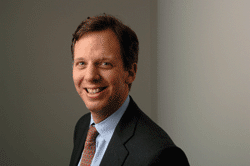Why performance matters | Lombard Odier: High performance from low risk | Dresdner: Bias and balance
 |
| Noland Carter: agnostic about how to buy exposure |
Rothschild’s sterling growth portfolio is indicative of the type used by entrepreneurs in the wealth creation phase who are comfortable taking risk, allocating relatively heavily to equities and alternatives. “The breakdown in asset allocation is between 50% and 80% in equities and between 20% and 30% in alternative investments. Cash and fixed-income allocations are both between zero and 10%,” says Kieron Launder, UK chief investment strategist of Rothschild Private Banking and Trust. Crucial to Rothschild’s success in outperforming its peers and the FTSE Private Banking UK (GBP) High Risk index in 2006 has been diversification. Investing on behalf of sterling-based investors differs from having a European investor base. “Equity allocation tends to be quite high because UK-based investors tend to invest heavily in equities,” says Rothschild’s UK CIO, Peter Martin. “While there would also be some allocation to fixed income, in 2006 the inverted yield curve meant that bonds offered little value and many clients lost interest. So we increased exposure to alternatives, including commodities, real estate, and hedge funds.”